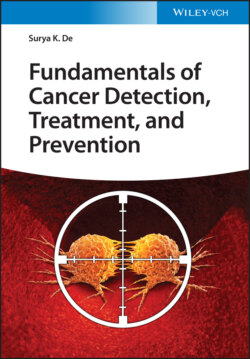Читать книгу Fundamentals of Cancer Detection, Treatment, and Prevention - Surya K. De - Страница 78
2.14 Possible Human Carcinogens
ОглавлениеA carcinogen is any substance that promotes carcinogenesis, the formation of cancer. An English physician John Hill first observed in 1761 that certain chemical exposures have been linked to the development of cancer [118]. He noted that the snuff users developed nasal cancer more frequently than the general population. Over 100 000 chemicals are used, and about 1000 new chemicals are listed each year, but not all chemicals are carcinogens. These chemicals are found in everyday items, including as foods, personal products, packaging, prescription drugs, and household and lawn care products [119–122]. While some chemicals may be harmful, not all contact with chemicals is dangerous to your health. Examples of known human carcinogens are asbestos, arsenic, benzene, beryllium, cadmium, nickel, vinyl halides, and others. Examples of possible human carcinogens are chloroform, DDT, polycyclic aromatic hydrocarbons, aromatic amines, azo dyes, nitrosamines and nitrosamides, hydrazo and azoxy compounds, carbamates, halogenated compounds, natural products, and others. DNA bases such as purine and pyrimidine are nucleophiles and react with any electrophiles resulting in DNA damage. Some reactive chemicals such as alkylating agents (alkyl halides), aldehydes, and others directly make a covalent bond with nucleophilic sites in the purine and pyrimidine rings of nucleic acids. Some chemicals react with DNA after being metabolized by the liver cytochrome P450 enzymes. For example, some alkenes and polycyclic aromatic hydrocarbons are metabolized by human liver enzymes to produce an electrophilic epoxide. DNA attacks the epoxide and is bound permanently to it and damages normal cells.
An estimation of some factors contributing to cancer development and their relative significance is shown in (Figure 2.19).
